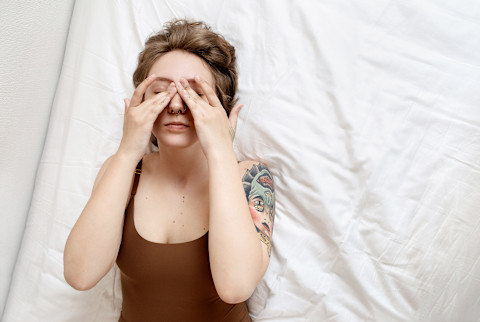
Anyone who's ever stared at a laptop all day and into the night can likely rattle off the symptoms of dry eyes—soreness, grittiness, redness, itchiness, blurriness, and for contact wearers, lenses that feel literally glued to the eyeball. While there are a number of culprits that can lead to dry eye, an often-overlooked issue tends to be one of the biggest triggers.
The surprising cause of dry eyes.
You probably already know that the base of our eyelashes plays host to countless bacteria. But contributing factors like, yes, way too much screen time, excessive dry air, hormones, and even aging can all create an environment ripe for bacterial overgrowth—especially if you're routinely going to bed without washing off that eye makeup. "We end up with an overpopulation when we're lax in our hygienic measures," explains optometrist Mary Ann Ellement, O.D.
Think of it as death by a thousand cuts. Little by little, all sorts of bad habits contribute to a real issue. "Dry-eye disease is a multifactorial, chronic, and progressive condition that if left untreated can significantly affect a patient's quality of vision," says Kambiz Silani, O.D., chief clinical director of Beverly Hills Optometry. It's characterized by one or more of all those symptoms too many of us have experienced:
What's more, "in later stages, a patient may develop intolerable levels of light sensitivity, vision fluctuation, corneal damage, ocular surface inflammation, and eye pain," says Silani.
How to treat dry eyes effectively.
Clearly, dry eye disease is more than just uncomfortable. But there is good news. Identifying lifestyle and environmental aggravators is a step in the right direction, and pairing that information with a few key remedies and best practices can help relieve symptoms of dry eye. "A combination of treatments is typically what I recommend to my patients," notes Ellement. "Most people who suffer from dry eye have had it for so long that it's no longer only the result of one factor." With that in mind, a well-rounded approach to eye care can be most effective for relieving symptoms of dry eye:
Minimize screen time.
OK, yes, this one can be challenging if you work on a laptop all day (guilty). But the effects of blue light on our health as a whole are becoming increasingly worrisome, and when it comes to eye health, one thing is clear: "When we're on screens, we only blink half as often as we do normally," says Ellement. "That causes the tear film to evaporate without being replenished and results in dry eyes."
Incomplete blinking is another issue associated with screen time, so try building in regular short breaks for this exercise:
- Close your eyes, then squeeze them tightly closed. Relax the squeeze, but don't open your eyes.
- Open your eyes and then repeat the whole sequence four more times.
This is quick and easy, so make a point of doing it at least three to four times a day, especially if you're on a screen.
Use warm compresses on your eyes—with this caveat.
Warm compresses on the eyes can be a wonderfully relaxing experience, especially at the end of a long, screen-filled day, but forget the wet-washcloth-in-the-microwave trick.
"The length of treatment and the amount of heat applied for warm-compress treatment is the key factor in its effectiveness," says Ellement. She explains that warm compresses need to be applied for at least 10 minutes, and the compress needs to stay warm the whole time. Eye masks like this one make it easy.
Get serious about eye hygiene.
Say it with me: I will never again go to bed without first washing off my eye makeup. There are so many problems associated with a habit like this, including eye irritation, itchiness, and infection. Snoozing in mascara, in particular, can dramatically thin your lashes and even cause them to fall out. And if you need any more motivation, "Makeup that isn't fully removed can create an unhygienic surface on which bacteria and eyelash mites thrive," notes Ellement.
Your favorite makeup tricks might be problematic, too. "Makeup can be a big factor in meibomian gland obstruction, particularly for people who apply makeup on the waterline." That's because they can't properly release lipids into the tear film when they're covered in makeup.
Consider a lid and lash solution.
If you're doing all of the above and still dealing with dry eyes, don't reach for the artificial tears. "They can provide temporary relief, but many people find they do not resolve the actual underlying dry eye problems," says Silani. Instead, try an actual lid and lash cleanser. "The bottom line is that a clean eye is a healthy eye, so use something that is designed to clean and disinfect to ensure proper eyelid hygiene."
One option is Avenova, a solution made with 0.01% hypochlorous acid, which is produced naturally in the body and clinically proven to kill bacteria and relieve a number of chronic eye conditions, including dry eye. "Avenova restores the natural homeostasis of the eyes by reducing the bacterial load without altering the diversity of bacterial species on the skin," says Silani. Incorporating a simple spray-and-swipe solution like this, morning and night, may offer some much-needed relief.
The takeaway.
There are a number of reasons you may be routinely dealing with dry eye, but relief isn't far away. Addressing the triggers that can lead to bacterial overgrowth, as well as that overgrowth itself, really can make all the difference.
